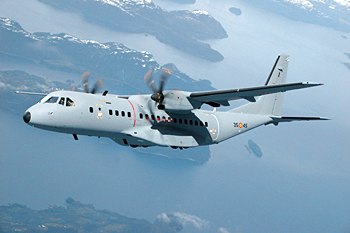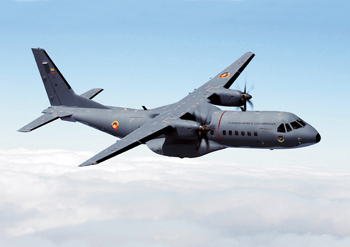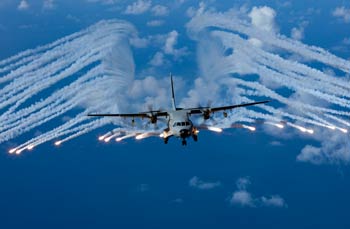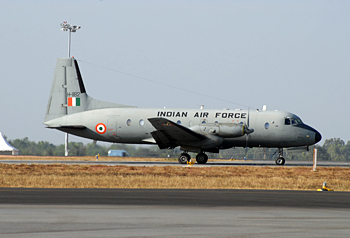INDIAN ARMED FORCES CHIEFS ON OUR RELENTLESS AND FOCUSED PUBLISHING EFFORTS

SP Guide Publications puts forth a well compiled articulation of issues, pursuits and accomplishments of the Indian Army, over the years

"Over the past 60 years, the growth of SP Guide Publications has mirrored the rising stature of Indian Navy. Its well-researched and informative magazines on Defence and Aerospace sector have served to shape an educated opinion of our military personnel, policy makers and the public alike. I wish SP's Publication team continued success, fair winds and following seas in all future endeavour!"

Since, its inception in 1964, SP Guide Publications has consistently demonstrated commitment to high-quality journalism in the aerospace and defence sectors, earning a well-deserved reputation as Asia's largest media house in this domain. I wish SP Guide Publications continued success in its pursuit of excellence.
The End of a Dilemma
The speed with which the DAC has cleared the “single vendor” Airbus-TASL proposal for the 56 C-295 aircraft is indicative of a welcome change in the approach of the bureaucracy towards defence procurement.
 |
By Air Marshal B.K. Pandey (Retd) Former Air Officer Commanding-in-Chief of Training Command, IAF |




Over the last two months, the Indian Air Force (IAF) has had its share of surprises that have been extremely pleasant. Just when hopes of getting the Rafale Medium Multi-Role Combat Aircraft (MMRCA) from Dassault Aviation of France through the process of global tender were beginning to fade, Prime Minister Modi sprung a surprise! The process of procurement of the badly needed combat aircraft in accordance with the Defence Procurement Procedure (DPP) seemed to have encountered an insurmountable impediment and there appeared to be no way out of the logjam. However, during his state visit to France in April this year, displaying an initiative that is unprecedented in the history of political leadership in India especially in the last decade, without any dithering, Prime Minister Modi set aside the stalled MMRCA tender and changed track to initiate a process with the Government of France for the direct procurement of 36 Rafale aircraft to begin with. As stated by the Minister of Defence Manohar Parrikar in a briefing to the media later on, the tendering process in this case that had been lingering for over seven years, had been a failure and that this particular requirement of the MMRCA which was so critical to national security, ought to have been progressed through the government-to-government route in the first place and not through the DPP. Implicit in the statement by the Minister of Defence was the fact that the DPP is totally inadequate to address the imperatives of national security. Essentially , the DPP is flawed and that the framework of rules there under is far too inflexible. There is certainly the need to restructure the DPP so as it to make it resilient enough to meet with the demands of national security and not have defence procurement deals mired in procedural complexities.
The DPP needs to be restructured to make it resilient enough to meet with the demands of national security and not have defence procurement deals mired in procedural complexities.
C-295 Deal Cleared by DAC
Even while the IAF was in the process of divining the intricacies and implications of the news on the revival of the possibility of getting the Rafale MMRCA in two years time, came another piece of encouraging news that elevated the spirits in the IAF. This news pertained to the Defence Acquisition Council (DAC) that is headed by the Minister of Defence, having cleared the proposal submitted jointly by Airbus Defence and Space along with the Indian partner Tata Advanced Systems Limited (TASL) for the supply of 56 C-295 twin-engine turboprop transport aircraft valued at 11,930 crore to replace the ageing Avro fleet on the inventory of the IAF. Of the 56 aircraft, 16 would be supplied by the original equipment manufacturer (OEM) in fly-away condition and the remaining 40 would have to be manufactured in India by the Indian partner in collaboration with the OEM.
This piece of news must have been a source of great comfort for the IAF as this tender floated under the DPP too had encountered a major roadblock. As the Airbus-TASL combine had been the only one to respond to the Request for Proposal (RFP) issued in 2013, it had turned out to be a “single vendor situation”, something that is normally not acceptable under the provisions of the DPP. Even though the DAC is empowered to provide waiver with due justification, it has generally refrained from doing so in the past. In fact there was a strong possibility that the tender would be cancelled and a fresh RFP would be issued in due course. However, the IAF was rightly apprehensive that in all likelihood, there would not be many takers for this project for a number of reasons. Firstly as the number of aircraft to be manufactured in India was limited to a mere 40 and there was no guaranteed access to the global market. Secondly that there was no private company in India that had the required level of experience and expertise in manufacturing or even assembling military or civil transport aircraft. Already bedevilled by uncertainty with practically all projects pertaining to procurement of aircraft, the IAF was certainly not looking forward to such a possibility as it would have only entailed further delay.
Proposal by the IAF was to involve the private sector of the Indian aerospace industry to build a platform to replace the fleet of HS-748 Avro aircraft in service.
Plan of the IAF to Replace the Avro Fleet
Induction of the Avro aircraft from the UK had commenced in the 1960s and subsequently, the Indian aerospace major Hindustan Aeronautics Limited (HAL) produced the aircraft under licence both for military and civilian use in the country. While the domestic national carrier then known by the name Indian Airlines, phased out the aircraft over two and a half decades ago, the IAF continues to operate around 50 of these machines in a tertiary role. Given the vintage of the fleet, it has become increasingly difficult to maintain the aircraft and provide a respectable level of flight line serviceability. Replacement of the Avro fleet was therefore overdue.
In September 2011, during a seminar on the Aerospace Industry in India that was attended by the Chief Executive Officers of a number of private companies associated with the aerospace industry in India, Air Chief Marshal NAK Browne, the then Chief of the Air Staff (CAS), IAF, spoke of the ingredients of the major expansion and modernisation plans that the IAF had embarked upon and the projects that were underway. One particular element of his public discourse that was a significant departure from the past, was the proposal submitted by the IAF to the Government in June that year to involve the private sector of the Indian aerospace industry in the effort of the IAF to build a platform to replace the fleet of HS-748 Avro aircraft that had been overtaken by obsolescence. The CAS was of the view that as HAL was already overstretched and was unable to meet with the time lines in respect of the projects already in hand, it would not be advisable to load this Defence Public Sector Undertaking further with new projects. Instead, it would be appropriate to give the fledgling private sector an opportunity to make a meaningful contribution to the military aerospace segment as well as break the monopoly of HAL through fair and healthy competition. A detailed analysis by the Government of HAL with regard to its backlog of orders and the capability of the Indian aerospace major to deliver in stipulated time frames, was supportive of the position as expounded by the CAS in the Seminar.
Opposition to the Proposal by the IAF
As expected, the proposal to exclude HAL from this project triggered response on predictable lines. Some of these even had the potential to stall the whole programme. The strongest objection came from Praful Patel who was then the Minister for Heavy Industries who shot off a letter to the then Prime Minister Dr Manmohan Singh. Praful Patel was of the view that as the state-owned HAL which is the only company in India that has the capability to assemble aircraft, it was inconceivable that it had been excluded from the project.
But perhaps the most bizarre observation came from a retired Director of HAL who not only wrote a detailed letter to the Ministry of Defence questioning the decision of the government with regard to barring HAL from participating in the project, he also went on to question as to why the IAF needed an aircraft of nine-tonne capacity to replace the Avro that could carry only five tonnes. If this logic was to be followed for induction of new aircraft, the IAF would never have been able to induct aircraft such as the IL-76 or the C-17 and would have remained stagnant with aircraft of the capacity of the Dakota DC-3 which could lift a payload of only three tonnes! Fortunately for the IAF, the then Minister of Defence AK Antony who was normally inclined to put projects on hold on receipt of even the most trivial complaint, thankfully chose to disregard these objections.
The C-295 and the IAF
Apart from filling the tactical airlift capability gap, the C-295 will help balance the structure of the transport fleet in the IAF.
The C-295 from Airbus Defence and Space is a combat-proven high performance medium capacity tactical transport aircraft. With a maximum takeoff weight of 23,200 kg, cruise speed of 480 kmph and range of 1,300 km at maximum payload, it carries 71 troops or a payload of 9.25 tonnes. Powered by two Pratt & Whitney PW-127G turboprop engines, it is designed for tactical airlift, search-and-rescue, maritime patrol and environmental surveillance missions. It is a high wing platform with a rear loading ramp that facilitates easy loading and offloading of cargo pallets, passengers, vehicles, equipment for medical evacuation, communication and logistic duties or for dropping paratroopers behind enemy lines. It has proved cost-efficient to operate and offers better economy in operations against comparable aircraft over its service life. The aircraft has been proven in the wars in Iraq and Afghanistan.
The C-295 will help bridge the tactical airlift capability gap that was developing in the transport fleet of the IAF. The recent acquisitions such as the C-17 Globemaster III and even the so called tactical transport aircraft, the C-130J Super Hercules are all with payload capacity ranging from 20 to 75 tonnes. The six-tonne payload capacity An-32 inducted beginning in the mid-eighties, is ageing and will be due to retire in a decade or so. Unfortunately, the availability its replacement, the Multi-role Transport Aircraft to be produced by HAL in collaboration with Russian companies, cannot be predicted with any degree of certainty. The IAF needs a tactical transport aircraft under ten-tonne payload capacity and the C-295 is certainly a good option. Apart from filling the tactical airlift capability gap, it will help balance the structure of the transport fleet in the IAF.
Welcome Macro-level Changes in the Offing
Despite some initial hesitation, the speed with which the DAC has cleared the Airbus-TASL proposal for the 56 C-295 aircraft is indicative of a welcome change in the approach of the slow moving civilian and military bureaucracy towards defence procurement. Indeed the Minister of Defence Manohar Parrikar, though new to the Ministry, appears to have been able to reenergise the organisation imparting it momentum through instilling into it a sense of purpose. Apart from a major revamp of the DPP currently underway that will have enhanced focus on simplification of procurement procedures and a distinct thrust on Make in India philosophy, the Minister of Defence is also instituting a system of better control over the functioning of the bureaucracy through periodic reviews, regular feedback and penalty for under-performance especially in the area of defence procurement which ultimately has a direct bearing on national security.
The Indian armed forces can now look forward to good days ahead at least during the tenure of the Modi-led NDA government!





